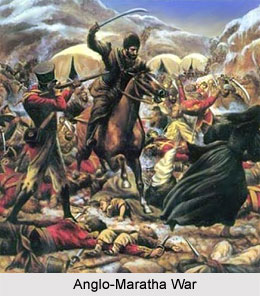 First Anglo-Maratha War: The growing rift in the Maratha Confederacy, called for an encounter between the two camps. In 1779`s January, at Talegon, the British was tossed by the Marathas. Subsequently , the Treaty of Wadgaon robbed all territories of the British from 1773.
First Anglo-Maratha War: The growing rift in the Maratha Confederacy, called for an encounter between the two camps. In 1779`s January, at Talegon, the British was tossed by the Marathas. Subsequently , the Treaty of Wadgaon robbed all territories of the British from 1773.
The conflagration of Anglo-Maratha quarrel was lit up.Warren Hastings , the British general bent upon recreating the earlier prestige, captured Bassein once again in 1780. Morever, the British annexed Mahadji Sindhia`s Gwalior on February,1781. The English forced Mahadji to serve as an ally, henceforth. The Treaty of Salbai , formulated on May, 1782, ascertained mutual restitution of each other`s holdings and peace for twenty years.This treaty was officially confirmed by Warren Hastins on June 1782 and by Nana Phadnavis on February 1783.The most salient feature of the treaty was that the British approved of Madhav Rao Narayan as the Peshwa. They also gave back to Sindhia all his territories west of Yamuna.The British for the time being healed the headache called Maratha Confederacy. The First Anglo-Maratha war, thus was terminated in 1782.
With the melancholic suicide of Madhav Rao Narayan Peshwa on October, 1795, Baji Rao, son of Raghunath Rao , settled as the Peshwa on December 4, 1796. Nana Phadnavis who worked as minister to him, did not survive long for ceasing the Maratha downfall. Meanwhile, Nizam strengthened his hold over Kharda.
The rival factions of the Sindhias and the Holkars, polluted intenal order. The Peshwas` favour for the Sindhias, alienated the irked Holkars, who rose up in arms to obliterate the Peshwas and Sindhias on October, 1801. Baji Rao was relegated to the background in Bassein. Jaswant Rao Holkar made Vinayak Rao the Peshwa.
The British happily utilized the prevalent disturbance. The aggressor Lord Wellesley`s Subsidiary Alliance, engineered to engulf native autonomy, swallowed the foolish Baji Rao through the Treaty of Bassein, on December 31, 1802. The hoax of permanently stationing 6,000 English soldiers for the Peshwas` safety, deceptively wanted for its` maintenance the payment of twenty-six lakh rupees to the East India Company. The English backed up Baji Rao`s ascension, to the Peshwaship again on May 13,1803.The humiliating Treaty of Bassein infuriated the Sindhias and the Bhosles, and welcomed the Second Anglo-Maratha War in 1803`s August.
Second-Anglo Maratha War : September 23, 1803, the Maratha unity was utterly defeated. Fortresses of Asirgrah and Gawilgrah, became British possessions. The Bhosles signed the Treaty of Deogaon(December 17,1803), a Subsidiary Alliance.They surrendered a lot of land-property, including the province of Cuttack . The condition of the Sindhias was not better. They too agreed to a Subsidiary arrangement called the Treaty of Surji-Arjanaon(December 30,1803). They lost a lions` share of their land , covering the territories between Ganga and Yamuna, Fort of Ahmadnagar, the areas of the Ajanta Ghat and river Godavari and the harbour of Bharuch. The Marathas were left on the verge of decomposition.
Third Anglo-Maratha War(1817-1819) : Warren Hastings` conquests on the Maratha territory to vanquish the Pindari robber bands, enraged the Maratha Peshwa Baji Rao of Pune(who participated in the Battle of Khadki), the Bhosles of Nagpur and the Holkars of Indore. They combinedly campaigned against the British. But by 1818, Pune was taken away from the Peshwa and incorporated into the Bombay Presidency . The north of Bhosle`s Nagpur, and Bundelkhand of the Peshwa were conquered . The Maratha kingdoms of Indore, Gwalior, Nagpur and Jhansi were made into princely states , admitting British dominance.
Baji Rao was exiled to Bithoor by the British. There he adopted Nana Sahib, born to Narayan Bhatt and Ganga Bai. He succeeded Baji Rao. His close associates were Tantiya Tope and Azimullah Khan, brotherly figures,who would aid him in his political enterprise.The deceitful British , stopped delivery of pension to Nana Sahib, on grounds of him not being a natural heir. This initiative on the part of the British , hurt him to the core.
He played the role of a leader in India`s First War of Independence. Together with Rani Lakshmi Bai of Jhansi , he operated attacks into the very heart of the colonial foundation. Though at the end they could not overthrow British imperialism in India, still they quaked the roots of British power in India.
The dazzling example of unflinching Maratha patriotism provided the spark to the fire of rebellion . It burnt not only within the non-conformists of the British rule during the Revolt of 1857, but was sustained in the future freedom-fighters like Tilak , who looked upto these awe-inspiring ideals of Nana Sahib and Lakshmi Bai , saluting the archetypal crusader, Shivaji.






































